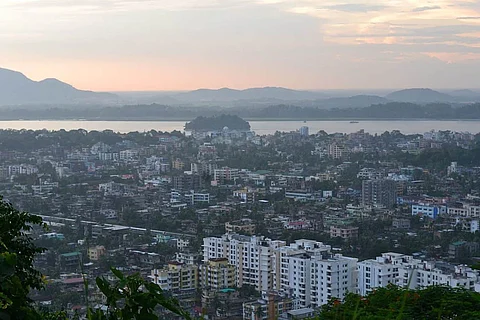
- Home
- Live Blog
- Breaking News
- Top Headlines
- Cities
- NE News
- Sentinel Media
- Sports
- Education
- Jobs

Guwahati’s Air Quality Index (AQI) deteriorating to the “poor” category on Friday has sounded the alarm bell for the city authorities to take urgent mitigation measures before things get worse. Addressing the air quality problem in the city requires both short-term and long-term measures. The AQI of the city was 204, according to the daily AQI bulletin released by the Central Pollution Control Board. The prominent pollutant in the city is PM 2.5, which implies that city residents are exposed to breathing in particulate matter – the tiny particles that pose the greatest health risk. The air quality of the city was worse than Delhi with AQI of the national capital found to be “moderate” with AQI 156. Dust particles from construction and demolition waste from construction sites across the city are suspended in the city air making it difficult for people with breathing problems to inhale fresh air outside their homes. Apart from the large construction projects of building two major flyovers, the construction of a drainage network in most localities has led to the release of copious amounts of dust into the air. Construction of two flyovers along the two busiest roads of the capital city- G.S. Road and M.G. Road-has resulted in traffic congestion leading to worsening of vehicular pollution. As construction activities are ongoing, the city authorities not anticipating the likely impact of these on AQI is baffling. The city drainage needs overhaul and construction of the drains replacing the inefficient drainage system with a scientific and efficient drainage system is an urgent necessity to provide a permanent solution to waterlogging and comprehensive liquid waste management. Haphazard dumping of construction materials, and sludge extracted from drains along narrow arterial city roads and bye-lanes during the ongoing drain construction is reflective of the absence of a monitoring mechanism on the part of the city authorities to find out about the difficulties faced by residents as well as other citizens who are required to use these roads and bye-lanes for their daily commuting. The construction workers do not listen to residents and contractors are also not to be seen regularly in some localities to listen to residents and make alternative arrangements to lessen their problems. They are taking advantage of the lack of monitoring by the authorities concerned and remain indifferent to the woes of residents and other people. It points towards serious gaps in the planning process during which such problems can be anticipated, and guidelines issued to project developers or contractors to take care to ensure that the execution of project causes minimum difficulties to the people, the targeted beneficiaries of these projects. The lack of coordination among various departments and agencies has made things worse. Contractors digging roads for laying underground cables, water pipes, providing household water connection, construction of piped gas networks etc. and then leaving the sites unrepaired has resulted inthe creation of dangerous potholes in many localities. This has further reduced the effective carriageway of already narrow lanes and slowed down traffic which has led to more carbon emissions and worsening of vehicular pollution. In the absence of rainfall, spraying of water at the construction and demolition sites can reduce releasing of dust from these sites into the air. The project planning has an inherent deficiency of not incorporating an effective monitoring mechanism to ensure that project developers and contractors mandatorily spray water on a daily basis to prevent dust generation during the dry season. The elected representatives of Guwahati Municipal Corporation have also miserably failed to make the required intervention to provide relief to citizens and meaningfully contribute towards addressing the problem of deteriorating AQI in the city. The elected representatives visiting the construction sites regularly and conveying the difficulties faced by people in their localities can impress upon the authorities about the need to promptly address those. The result of such intervention will go a long way in addressing the overall air pollution problem in the city. Traffic congestion worsening during construction of two major flyovers is not unexpected but what lacks is efficient traffic planning and management to undertake short-term measures to reduce it. People too can play their part in improving traffic management by avoiding the roads when construction activities are on by travelling through alternate routes and voluntarily refraining from parking vehicles along roadsides gripped by worsening traffic congestion on account of construction work so that effective carriageway can be maximised by moving traffic. Efficient city traffic management requires both robust planning by authorities and city residents and visitors playing a responsible role in assisting the authorities in implementing it to prevent congestion. Increasing the green cover of the city is the most important and urgent requirement for achieving the long-term goal of building a sustainable city with clean air. Lessons must be learnt from the cyclical worsening of AQI during the peak of construction activities during the dry season to plan and execute effective mitigation strategies.